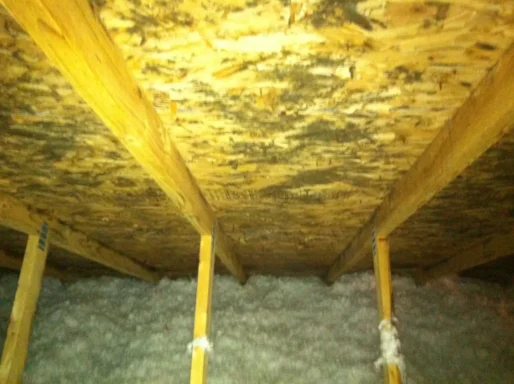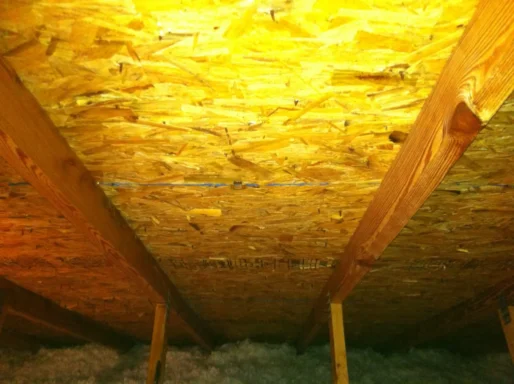Rely on decades of experience and expert training to clean up your attic mold. With top-tier education, advice, testing, and remediation, we help you breathe easier. sell your home. improve your health. live comfortably.


You Discover Hidden Mold in Your Attic
Your house is as good as sold. You’ve already selected your new dream home, but now there’s a problem. Your buyer’s home inspector found mold in the attic, putting your sale at risk and raising concerns for your family’s health and well-being.
This scenario is becoming more common. Newer homes are built with lumber that is more porous and more susceptible to moisture penetration than older homes. New homes are also sealed up tighter for greater heating and cooling efficiency, leading to a buildup of moisture. In addition, home inspectors, other contractors, and even homeowners are more aware of mold issues. Whatever the situation, the likelihood that you will need to deal with mold in your attic is now higher than ever.
Your Trusted Ally: Indiana Mold Remediation
When it comes to addressing the unique challenges of attic mold, Indiana Mold Remediation is your dependable partner. We’re here to guide you in reclaiming your home’s value and ensuring your family’s safety.
A Clear Solution for a Healthy Attic
Our approach is straightforward and highly effective. We apply a specialized attic mold treatment to eradicate the issue and safeguard your home’s sale. We prioritize simplicity, ensuring a clean attic in no time.
Our priority is to keep you well-informed throughout the process, ensuring you’re always up to speed with the latest developments. With your permission, we’re happy to extend this communication to anyone else you specify, including your agent, keeping all parties you deem important informed and involved.
Our Streamlined Treatment Process is Quick and Hassle-Free
In this video, you can see the transformation of a mold-infested attic into a clean, healthy space in a remarkably short time. At Indiana Mold Remediation, we understand how valuable your time and well-being are to you. That’s why we’ve tailored our treatment process to be both minimally invasive and as efficient as possible. You can count on us to be out of your way quickly, without compromising on quality. Let us help you restore your attic—and peace of mind—with our quick and hassle-free service.
Take the Next Step: Schedule Your Attic Mold Treatment
Ready to regain control of your attic and ensure a successful home sale, all while prioritizing your family’s health? Contact Indiana Mold Remediation today to schedule your attic mold treatment. We’re here to support you on your journey toward a healthier home and a smooth real estate transaction.
Avoiding the Consequences of Mold
You’re not merely taking a step toward a mold-free attic – you’re preventing potential issues that arise from untreated mold, securing a successful home sale, and maintaining your property’s value. Mold, when left unaddressed, can jeopardize your real estate investment, reduce property value, and pose health concerns for your family. Don’t let mold-related problems hinder your home sale, affect your health, or ruin your day. Allow us to help you create a worry-free attic space today.
A Healthy and Worry-Free Attic
Our tried-and-true treatment and prevention solutions provide peace of mind for your family and ensure a successful real estate transaction. You’re not just protecting your home’s sale, preserving its value, and ensuring your family’s well-being; you’re also making a wise investment in your home’s future. Join the ranks of homeowners who have transformed their attics, secured a successful sale, and maintained a healthy and worry-free living environment. Let success be your story with Indiana Mold Remediation.
Got a question?
No problem.
We are always ready to help with the answers.
Or call (317) 867-4766 – (también en español)
Attic Mold Remediation FAQ
Frequently asked questions about mold and attics. Please contact us for more information or if you have additional questions.
Can mold go away on its own?
No, mold doesn’t just go away. It should stop growing if you solve the moisture issues, but the mold will remain without further action.
How do I stop mold from growing in my attic?
The best way to stop mold from growing in an attic is to keep the attic clean and dry. See the section on what causes attic mold growth for information on sources of moisture.
Should moldy insulation be removed?
Moldy insulation should be removed from the attic. Mold does not usually grow on fiberglass insulation, but it can grow on the paper backing, and it grows on other forms of insulation; especially blown-in cellulose. These moldy materials should be removed during the remediation process.
Can poor attic insulation cause mold?
Poor attic insulation or improper ventilation can cause moisture problems that lead to mold growth. This is a common problem in homes in humid environments like Indiana. If you have mold in your attic, it is probably wise to look at ventilation and insulation if no other obvious moisture sources are present.
Can mold in the crawl space cause attic mold growth?
Yes. Mold spores, and especially moisture, from the crawl space can move up through the house and cause issues in the attic. If the water vapor condenses on the bottom of the roof decking, you’re going to have persistent moisture and mold problems in the attic space. In a case like this, you probably want to evaluate the interior of the home for moisture problems as well; there could be hidden mold in the walls or flooring.
What Causes Mold Growth in Attics?
Mold requires three things to grow: oxygen, water, and a source of food. Since oxygen and food sources for mold are abundant, the most effective way to limit mold growth is by reducing the amount of available water. Below are some common ways water accumulates in attics, which often leads to mold growth.
Inadequate Ventilation
Attics need proper ventilation to allow moisture to escape. This can be done using powered exhaust fans or through vents in the roof as hot air rises and escapes. Usually, there are also soffit vents that allow air to enter the attic under the eaves.
If these components are missing or not functioning, warm air and moisture can become trapped. This causes water to condense out of the air against cold surfaces such as air ducts and cold roofs.
Insufficient Insulation
Attic insulation compresses over time, making it less effective. There also may not be enough insulation in the attic, or the insulation has been moved around, creating insufficient coverage.
Whatever the cause, too much warm air escaping into the attic can cause moisture condensation issues. This is commonly the cause of mold growth that is primarily on the north side of the roof, as that is the side with no direct sunlight and is often cooler than the rest of the roof, resulting in condensation of water on the surface. The fix is usually as simple as adding more insulation.
For extra protection, you may want to add a vapor barrier between the ceiling and the attic joists. This can be expensive to do unless it is done during construction before the ceiling drywall is installed.
Bathroom Exhaust Fans
Exhaust fans in bathrooms are intended to evacuate hot, steamy air out of the bathroom and vent it to the outdoors. If the vent is improperly installed, or if the duct becomes damaged, it may expel that air and moisture into the attic. This usually results in mold growth near the vent, but if left unchecked it can spread to the rest of the attic.
Excessive Moisture Intrusion
Even with proper ventilation and insulation, excessive moisture can cause mold growth. Because warm air in the home rises, moisture problems in the attic usually come from moisture inside the home or crawl space. There are many possible moisture sources in the home, but faulty humidifiers and pipe leaks are some of the more common.
Water Leaks
Roof leaks, pipe breaks, and other direct sources of water intrusion can lead to mold growth in the affected area. Without correction, this can lead to a buildup of moisture in the air, allowing the mold to spread to the rest of the attic.
Still Need Help With Your Attic?
Don't let uncertainty hold you back any longer. Begin your journey to a healthier, mold-free environment today. Reach out to Indiana Mold Remediation about your attic issues for a no-obligation 15 minute consultation at no cost.
Schedule My Free Consultation